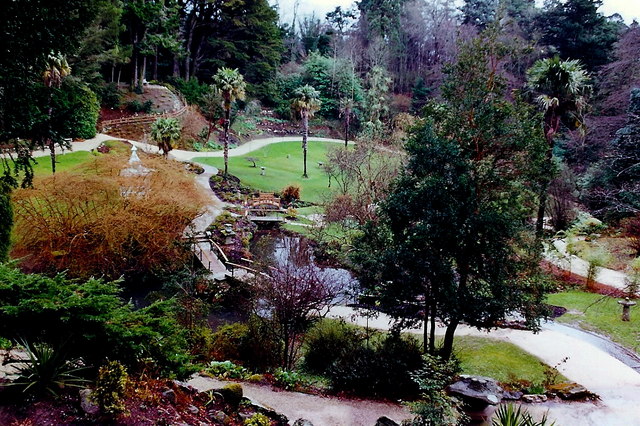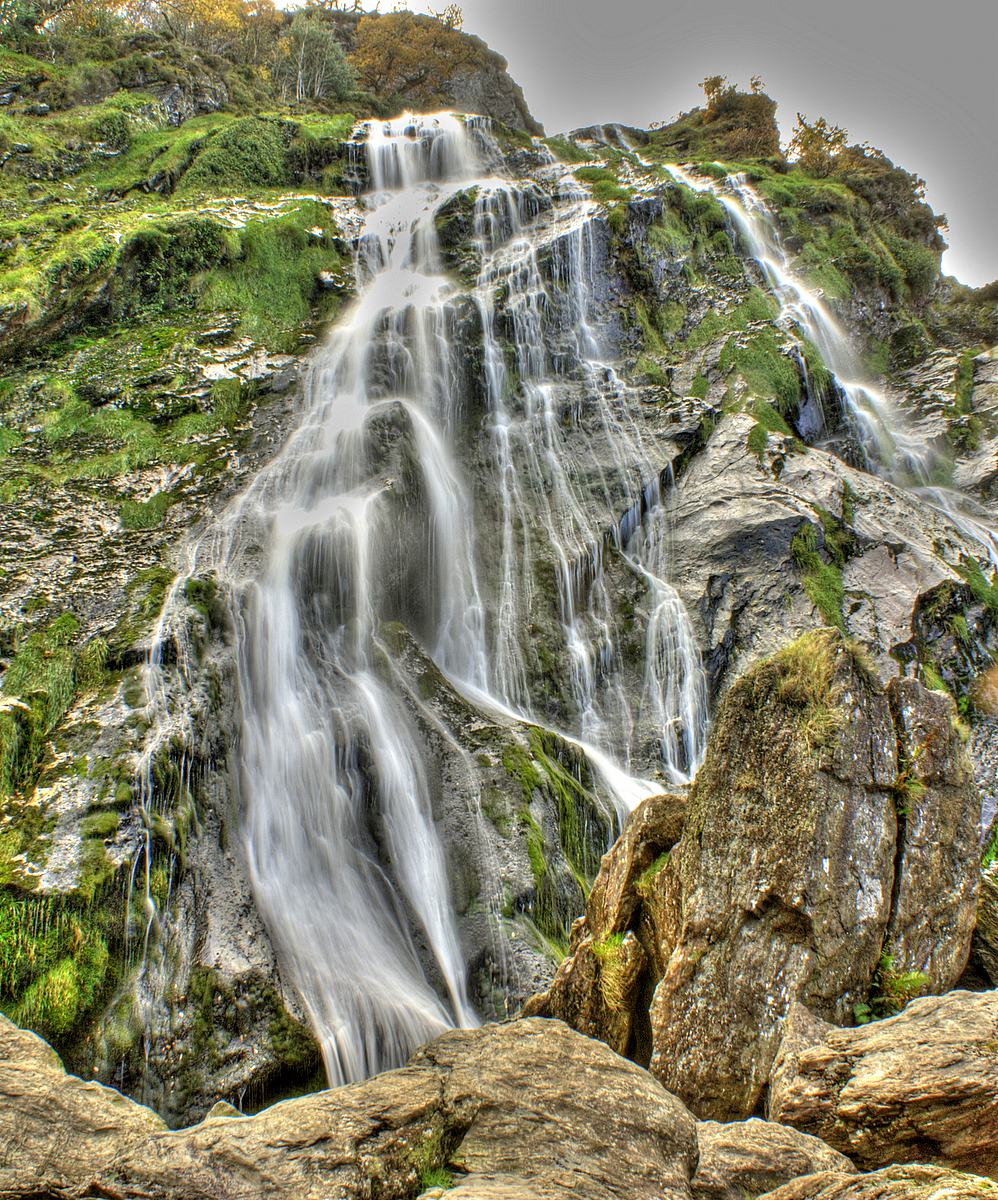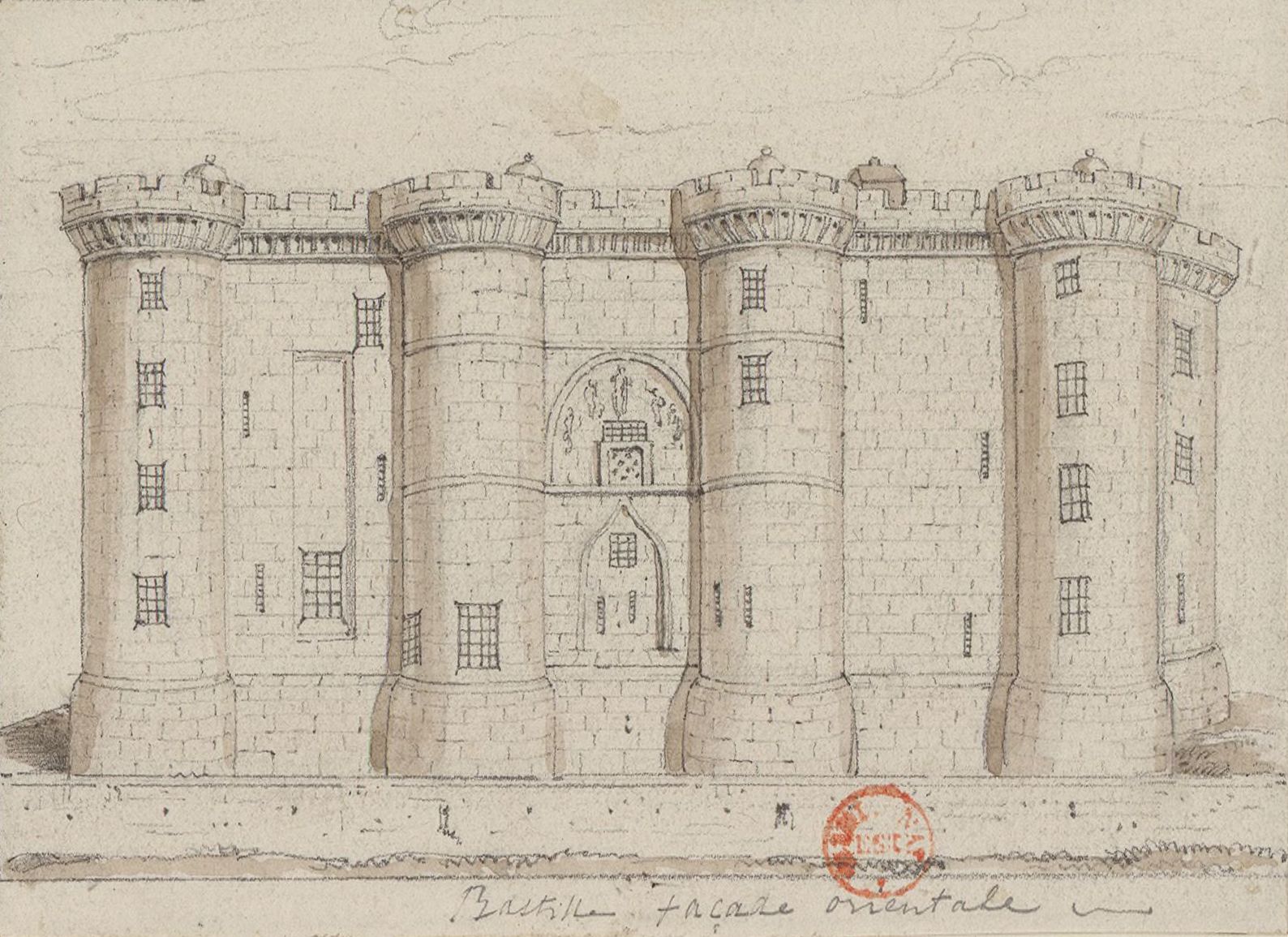|
Powerscourt Estate
Powerscourt Estate (), located in Enniskerry, County Wicklow, Ireland, is a large country estate which is noted for its house and landscaped gardens, today occupying . The house, originally a 13th-century castle, was extensively altered during the 18th century by German architect Richard Cassels, starting in 1731 and finishing in 1741. A fire in 1974 left the house lying as a shell until it was renovated in 1996. The Wingfield family had long coveted the lands of Phelim O'Toole of Powerscourt (d. 1603), seeking to draw Phelim O'Toole into an act of rebellion, the penalty for which was forfeiture. The feud climaxed on 14 May 1603 when the Wingfields murdered Phelim in the place known as the Killing Hollow near Powerscourt, despite the fact that Phelim's grandson and heir Turlough son of Phelim's son (d. 1616) remained in occupation of Powerscourt. King James I of England (d. 1625) on 27 October 1603 granted a lease of the manor of Powerscourt for 21 years to Sir Richard Wingfie ... [...More Info...] [...Related Items...] OR: [Wikipedia] [Google] [Baidu] |
Enniskerry, County Wicklow
Enniskerry (historically ''Annaskerry'', from ) is a village in County Wicklow, Ireland. The population was 2,008 at the 2022 census of Ireland, 2022 census. Location The village is situated on the Glencullen River in the foothills of the Wicklow Mountains in the east of the island, just 5 minutes south of the Dublin border and some south of Dublin city centre. The R117 road, colloquially known as "The Twenty-One Bends" connects the town to the main N11 road (Ireland), N11 road to Dublin. The 185 Go-Ahead Ireland route connects the village hourly to Bray, County Wicklow, Bray, the nearest large town. The 44 Dublin Bus route connects the village with Dublin city centre. History Enniskerry is a planned estate village dating from the 1840s, with the original buildings designed in a neo-Tudor style. The Protestant population of the village attended church in the grounds of the Powerscourt Estate, Powerscourt Demesne until 1859. Mervyn Wingfield, 7th Viscount Powerscourt, Mervyn ... [...More Info...] [...Related Items...] OR: [Wikipedia] [Google] [Baidu] |
Powerscourt House, Co
Powerscourt may refer to: * Powerscourt (horse) (born 2000), a thoroughbred racehorse * Powerscourt cocktail, a brandy-based cocktail * Powerscourt Covered Bridge, a Canadian McCallum truss bridge * Powerscourt Estate, County Wicklow, Ireland ** Powerscourt Golf Club, on the estate * Powerscourt House, Dublin, a townhouse, interior is now a shopping centre * Powerscourt Waterfall, Glensoulan Valley on the River Dargle, County Wicklow, Ireland * Lord Francis Powerscourt, a fictional detective * Viscount Powerscourt, a title in the Irish peerage {{disambiguation ... [...More Info...] [...Related Items...] OR: [Wikipedia] [Google] [Baidu] |
Richard Wingfield, 5th Viscount Powerscourt
Richard Wingfield, 5th Viscount Powerscourt (11 September 1790 – 9 August 1823) was an Anglo-Irish peer. He was the son of Richard Wingfield, 4th Viscount Powerscourt and Lady Catherine Meade, daughter of John Meade, 1st Earl of Clanwilliam. On 19 July 1809 he succeeded to his father's titles in the Peerage of Ireland. In 1821, he was elected as an Irish representative peer and took his seat in the House of Lords. In August 1821 Powerscourt hosted George IV at his family home, Powerscourt House, in County Wicklow. His time in the Lords was ended by his premature death in 1823. Powerscourt married twice; firstly to Lady Frances Theodosia Jocelyn, daughter of Robert Jocelyn, 2nd Earl of Roden and Frances Theodosia Bligh, on 6 February 1813. Following his first wife's death he married Theodosia Howard, daughter of Hon. Hugh Howard and Catherine Bligh, in August 1822. He was succeeded in his titles by his son, Richard Richard is a male given name. It originates, via Old ... [...More Info...] [...Related Items...] OR: [Wikipedia] [Google] [Baidu] |
King George IV
George IV (George Augustus Frederick; 12 August 1762 – 26 June 1830) was King of the United Kingdom of Great Britain and Ireland and King of Hanover from 29 January 1820 until his death in 1830. At the time of his accession to the throne, he was acting as prince regent for his father, King George III, having done so since 5 February 1811 during his father's final mental illness. George IV was the eldest child of King George III and Queen Charlotte. He led an extravagant lifestyle that contributed to the fashions of the Regency era. He was a patron of new forms of leisure, style and taste. He commissioned John Nash (architect), John Nash to build the Royal Pavilion in Brighton and remodel Buckingham Palace, and commissioned Jeffry Wyatville to rebuild Windsor Castle. George's charm and culture earned him the title "the first gentleman of England", but his dissolute way of life and poor relationships with his parents and his wife, Caroline of Brunswick, earned him the con ... [...More Info...] [...Related Items...] OR: [Wikipedia] [Google] [Baidu] |
The Hall At Powerscourt House, Co
''The'' is a grammatical article in English, denoting nouns that are already or about to be mentioned, under discussion, implied or otherwise presumed familiar to listeners, readers, or speakers. It is the definite article in English. ''The'' is the most frequently used word in the English language; studies and analyses of texts have found it to account for seven percent of all printed English-language words. It is derived from gendered articles in Old English which combined in Middle English and now has a single form used with nouns of any gender. The word can be used with both singular and plural nouns, and with a noun that starts with any letter. This is different from many other languages, which have different forms of the definite article for different genders or numbers. Pronunciation In most dialects, "the" is pronounced as (with the voiced dental fricative followed by a schwa) when followed by a consonant sound, and as (homophone of the archaic pronoun ''thee' ... [...More Info...] [...Related Items...] OR: [Wikipedia] [Google] [Baidu] |
Palladian
Palladian architecture is a European architectural style derived from the work of the Venetian architect Andrea Palladio (1508–1580). What is today recognised as Palladian architecture evolved from his concepts of symmetry, perspective and the principles of formal classical architecture from ancient Greek and Roman traditions. In the 17th and 18th centuries, Palladio's interpretation of this classical architecture developed into the style known as Palladianism. Palladianism emerged in England in the early 17th century, led by Inigo Jones, whose Queen's House at Greenwich has been described as the first English Palladian building. Its development faltered at the onset of the English Civil War. After the Stuart Restoration, the architectural landscape was dominated by the more flamboyant English Baroque. Palladianism returned to fashion after a reaction against the Baroque in the early 18th century, fuelled by the publication of a number of architectural books, including Pal ... [...More Info...] [...Related Items...] OR: [Wikipedia] [Google] [Baidu] |
Sir John Vanbrugh
Sir John Vanbrugh (; 24 January 1664 (baptised) – 26 March 1726) was an English architect, dramatist and herald, perhaps best known as the designer of Blenheim Palace and Castle Howard. He wrote two argumentative and outspoken Restoration comedy, Restoration comedies, ''The Relapse'' (1696) and ''The Provoked Wife'' (1697), which have become enduring stage favourites but originally occasioned much controversy. He was Knight Bachelor, knighted in 1714.Robert Chambers, Book of Days Vanbrugh was in many senses a radical throughout his life. As a young man and a committed Whigs (British political party), Whig, he was part of the scheme to overthrow James II of England, James II and put William III of England, William III on the throne. He was imprisoned by the French as a political prisoner. In his career as a playwright, he offended many sections of English Restoration, Restoration and 18th century society, not only by the sexual explicitness of his plays, but also by thei ... [...More Info...] [...Related Items...] OR: [Wikipedia] [Google] [Baidu] |
Powerscourt Estate Terrance And Fountain (1800s) , a title in the Irish peerage
{{disambiguation ...
Powerscourt may refer to: * Powerscourt (horse) (born 2000), a thoroughbred racehorse * Powerscourt cocktail, a brandy-based cocktail * Powerscourt Covered Bridge, a Canadian McCallum truss bridge * Powerscourt Estate, County Wicklow, Ireland ** Powerscourt Golf Club, on the estate * Powerscourt House, Dublin, a townhouse, interior is now a shopping centre * Powerscourt Waterfall, Glensoulan Valley on the River Dargle, County Wicklow, Ireland * Lord Francis Powerscourt, a fictional detective *Viscount Powerscourt Viscount Powerscourt ( ) is a title that has been created three times in the Peerage of Ireland, each time for members of the Wingfield family. It was created first in 1618 for the Chief Governor of Ireland, Richard Wingfield. However, this creat ... [...More Info...] [...Related Items...] OR: [Wikipedia] [Google] [Baidu] |
Beech Trees
Beech (genus ''Fagus'') is a genus of deciduous trees in the family Fagaceae, native to subtropical (accessory forest element) and temperate (as dominant element of mesophytic forests) Eurasia and North America. There are 14 accepted species in two distinct subgenera, ''Englerianae'' and ''Fagus''. The subgenus ''Englerianae'' is found only in East Asia, distinctive for its low branches, often made up of several major trunks with yellowish bark. The better known species of subgenus ''Fagus'' are native to Europe, western and eastern Asia and eastern North America. They are high-branching trees with tall, stout trunks and smooth silver-grey bark. The European beech ''Fagus sylvatica'' is the most commonly cultivated species, yielding a utility timber used for furniture construction, flooring and engineering purposes, in plywood, and household items. The timber can be used to build homes. Beechwood makes excellent firewood. Slats of washed beech wood are spread around the bottom ... [...More Info...] [...Related Items...] OR: [Wikipedia] [Google] [Baidu] |
Glencullen River
The Glencullen River (), often the ''Cookstown River'' (') below Enniskerry, is a watercourse of Dún Laoghaire–Rathdown (in southern County Dublin) and northern County Wicklow County Wicklow ( ; ) is a Counties of Ireland, county in Republic of Ireland, Ireland. The last of the traditional 32 counties, having been formed as late as 1606 in Ireland, 1606, it is part of the Eastern and Midland Region and the Provinces .... It is about long; it passes the nature reserve of Knocksink Wood and the village of Enniskerry, and joins the River Dargle near Bray. The river is in the jurisdictions of Dún Laoghaire–Rathdown County Council, Dún Laoghaire–Rathdown and Wicklow County Councils, as well as within the purview of the Environmental Protection Agency (Ireland), Environmental Protection Agency. Name The river is named for its source valley, the name of which means "the Holly Glen". Its alternate English-language name refers to an area near Enniskerry, while the Irish- ... [...More Info...] [...Related Items...] OR: [Wikipedia] [Google] [Baidu] |
Glencree
Glencree ( from the older Gleann Criothach, which translates as Valley of the Shaking Bog) is a valley in the Wicklow Mountains in eastern Republic of Ireland, Ireland. It is the third-closest valley in the mountains to Dublin city, the first being Glencullen and the second Glenasmole. The River Dargle flows down the valley, which rises to a height of about 400 metres (1,312 feet). The foot of the valley is the site of the village of Enniskerry. In medieval times it was heavily wooded and was a royal forest, apparently the only royal forest in Ireland. The trees seem to have mainly been oak. The name of at least one Royal Forester at Glencree is known, Sir Thomas Fitzadam, who was appointed in 1219. The barracks The top of the glen emerges onto the military road, constructed by the British Army in the early 19th century in order to hunt down the United Irishmen guerrillas, holding out in the mountains after the Irish Rebellion of 1798. A barracks was built just off the road in 1 ... [...More Info...] [...Related Items...] OR: [Wikipedia] [Google] [Baidu] |
River Dargle
The River Dargle () is a river that flows from the Wicklow Mountains in Ireland to the Irish Sea. It forms Powerscourt Waterfall, receives the Glencree and Glencullen Rivers, and later the Glenmunder Stream / County Brook, and the Swan River at Bray, and reaches the sea at Bray Harbour. Course The Dargle rises in the Wicklow Mountains, Republic of Ireland, Ireland, on the southern slopes of Tonduff . It flows down the Glensoulan hanging valley, to fall over the Powerscourt Waterfall. The Dargle then flows through the Glencree valley where it is fed by the River Glencree, before flowing east for a further . It receives the Glencullen River, and later the Glenmunder Stream, also known as the County Brook or Ballyman Stream. A final small tributary, the Swan River, joins opposite the People's Park, Little Bray. The final section reaches the Irish Sea at Bray, County Wicklow, Bray Harbour. Name The river's name in Irish language, Irish, , refers to the tint of red in the rocks ... [...More Info...] [...Related Items...] OR: [Wikipedia] [Google] [Baidu] |






